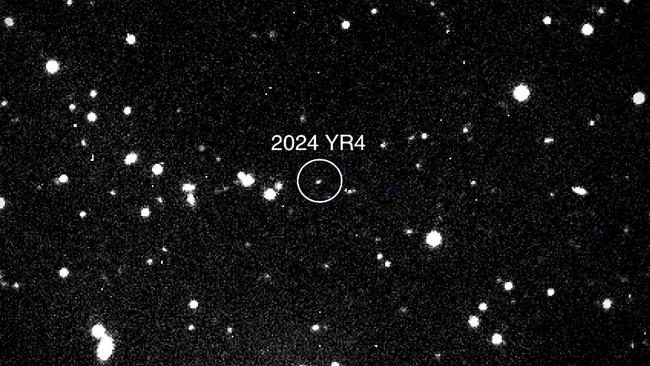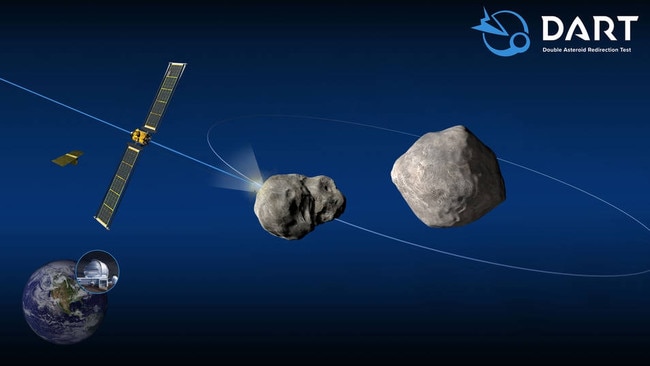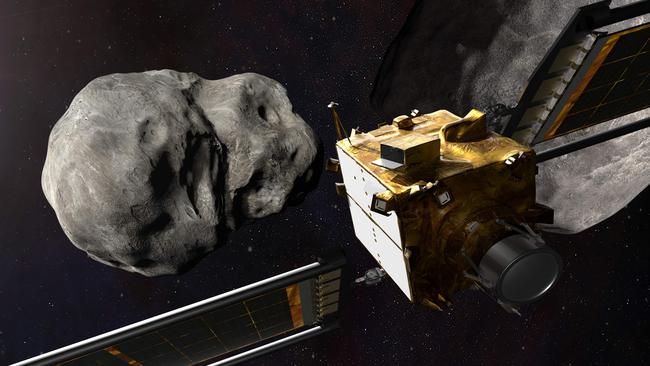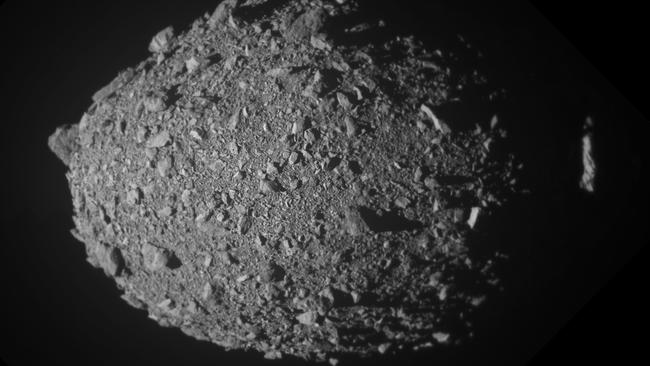NASA says ‘city killer’ asteroid 2024 YR4 now has 3.1% chance of hitting Earth
NASA has just raised the odds of a “city killer” asteroid hitting Earth to the greatest level ever in modern forecasting.
An asteroid that could level a city now has a 3.1-per cent chance of striking Earth in 2032, according to NASA data - making it the most threatening space rock ever recorded by modern forecasting.
Despite the rising odds, experts say there is no need for alarm.
The global astronomical community is closely monitoring the situation and the James Webb Space Telescope is set to fix its gaze on the object, known as 2024 YR4, next month.
“I’m not panicking,” Bruce Betts, chief scientist for the non-profit Planetary Society told AFP.
“Naturally when you see the percentages go up, it doesn’t make you feel warm and fuzzy and good,” he added, but explained that as astronomers gather more data, the probability will likely edge up before rapidly dropping to zero.

2024 YR4 was first detected on December 27 last year by the El Sauce Observatory in Chile.
Astronomers estimate its size to be between 130 and 300 feet (40-90 meters) wide, based on its brightness.
Analysis of its light signatures suggests it has a fairly typical composition, rather than being a rare metal-rich asteroid.
The International Asteroid Warning Network (IAWN), a worldwide planetary defence collaboration, issued a warning memo on January 29 after the impact probability had crossed one per cent.
Since then, the figure has fluctuated but continues to trend upward.
NASA’s latest calculations estimate the impact probability at 3.1 per cent, with a potential Earth impact date of December 22, 2032.
That translates to odds of one in 32 - roughly the same as correctly guessing the outcome of five consecutive coin tosses.
The last time an asteroid of greater than 30 meters in size posed such a significant risk was Apophis in 2004, when it briefly had a 2.7 per cent chance of striking Earth in 2029 - a possibility later ruled out by additional observations.
Surpassing that threshold is “historic,” said Richard Moissl, head of the European Space Agency’s planetary defence office, which puts the risk slightly lower at 2.8 per cent.
THIS IS WHAT WOULD HAPPEN IF IT HITS
Chilling animations depict the apocalyptic impact that “city-killer” asteroid YR4 2024 could have if it did hit Earth — while astronomers warn that the moon could be in the line of fire as well.
“Showing just over ~2 per cent impact probability on Earth,” Dr David Rankin, operations manager of the University of Arizona’s Catalina Sky Survey, wrote in a viral post on Blue Sky Social, alongside a video simulation of the rock’s potential impact.
He specifically calculated that 2024 YR4 — which is around the size of the Leaning Tower of Pisa — would have around a one in 48 chance of striking the Earth on December 22, 2032.
His accompanying line graph video shows the precise collision source that could lead to Armageddon. If it does hit home, the dangerous space rock could release an energy blast equivalent to 8 megatons of TNT, capable of obliterating an area the size of Washington, DC, SWNS reported.
A dramatic YouTube simulation created by 3D animation wizard Alvaro Gracia Montoya shows a massive space rock laying waste to a metropolis like something out of a Roland Emmerich disaster flick.
The one silver lining is that Dr. Rankin’s forecast is slightly less dire than current estimates, which assert that YR4 has a 2.3 per cent chance of hitting our planet, putting it at the top of NASA’s list of interstellar threats.
The moon, unfortunately, could also be in the asteroid’s path; Rankin calculated that it has a 0.3 per cent chance of sustaining a deep impact.
Unlike the Earth, our natural satellite lacks an atmosphere to shield it, so YR4 would hit at around 48,280 km per hour, according to the New Scientist.
This would potentially generate an explosion 343 times the size of the Hiroshima bomb and leave a blast crater measuring between 499 metres to 1981 metres across.
Fortunately, our planet would emerge from a potential lunar crash-landing relatively unscathed.
“There is the possibility this would eject some material back out that could hit the Earth, but I highly doubt it would cause any major threat,” Dr Rankin said.
Although he noted that the collision “would likely be very visible from Earth,” per Live Science.
EXPERT’S WARNING OVER NEAR-EARTH ASTEROID
An award-winning UK scientist warned that it might be too late to deflect the “city killer” asteroid that’s headed toward Earth.
Deflection efforts “might not be able to stop 2024 YR4,” cautioned Robin George Andrews, a London volcanologist and author, in a chilling X post blowing up online.
Discovered hurtling through our galaxy in December 2024, the building-size space rock is reportedly at the top of NASA’s watch list when it comes to deep space dangers, boasting a 1 in 43 chance of striking Earth in 2032.
And while the odds of Armageddon might seem slim, Andrews believes that we’re in big trouble if the intergalactic gravel is indeed on a collision course with our planet.
The scientist threw cold water on the defence potential of the DART (the Double Asteroid Redirection Test) spacecraft, which was successfully used to knock the 580-foot-wide asteroid Dimorphos off course in 2022.

This cosmic kamikaze mission reportedly shortened its orbit by more than half an hour, potentially paving the way for humans to alter the trajectory of other dangerous cosmic bodies.
While Andrews acknowledged that this celestial crash test “worked wonders,” he warned that this doesn’t mean we can “deflect any asteroid whenever we want.”
“So much could go wrong if we try and hit it with something like DART,” said the researcher.
He noted that many asteroids are loose rubble piles of sand, dirt and boulders tethered tenuously together by gravity. When hit, they could fragment and potentially send interstellar shrapnel hurtling toward Earth — a phenomenon Andrews analogised to “turning a cannonball into a shotgun spray.”

Even if the strike was successful, there might not be enough time to significantly alter the asteroid’s path, warned the scientist. He noted that YR4 is arriving in just eight years, while it takes “10 years or more to build, plan and execute an asteroid deflection mission.”
“This is because the deflection a kinetic impactor can give an Earthbound asteroid would be tiny,” he said, noting that DART only altered Dimorphos’ velocity by several millimetres.
“Only over time does the shifted orbit add up enough to ensure it’ll miss Earth.”
“With only a few years down the line, we could accidentally deflect it — but not enough to make it avoid the planet,” Andrews theorised.
“Then, it still hits Earth, just somewhere else that wasn’t going to be hit.”
This outcome could be catastrophic, given that a strike by YR4 would allegedly cause roughly the same amount of damage as the Tunguska event, which laid waste to around 80 million trees in Siberia in 1908, according to Space.com.

Despite the potential danger, Andrews assured the public that 2024 YR4 will “probably miss Earth.”
“But if it doesn’t, we have to be wary of trying to save the world but accidentally making the problem worse,” he said. “Maybe we’ll just have to get out of the asteroid’s way this time.”
NASA recently enlisted the aid of the James Webb telescope — the planet’s most powerful — to study 2024 YR4 and gauge how much damage it would cause if it did strike the Earth.
The instrument would help astronomers glean a more accurate measurement of the rock’s size by using its infra-red instruments to study the heat emitted by it.
This data will in turn be “used by ESA [the European Space Agency], NASA, and other organisations to more confidently assess the hazard and determine any necessary response,” the ESA wrote.
- with The New York Post and Agence France-Presse
More Coverage
Originally published as NASA says ‘city killer’ asteroid 2024 YR4 now has 3.1% chance of hitting Earth


